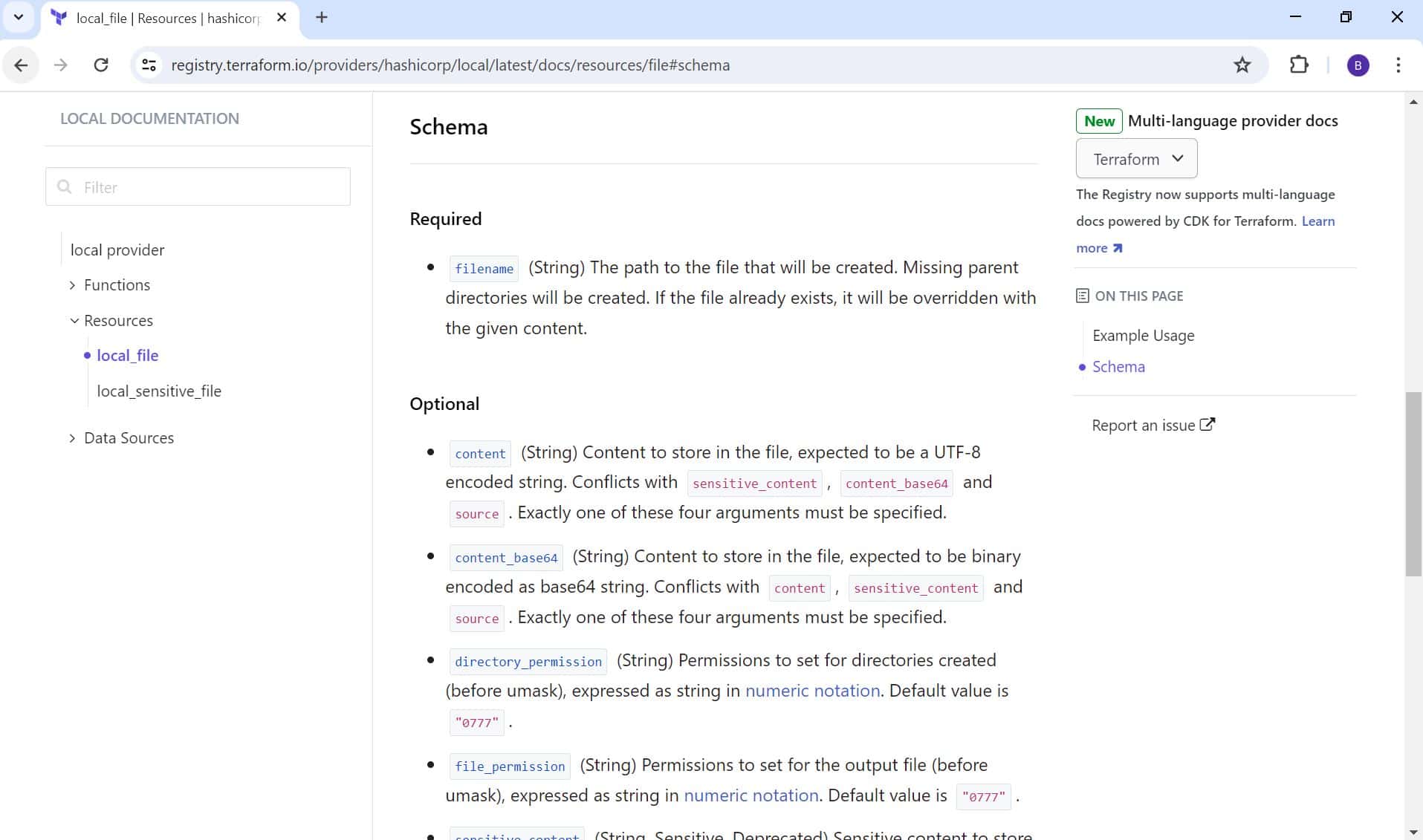1. 概述
Terraform 是一个基础设施即代码(IaC)工具,广泛用于云环境下的基础设施部署和管理。它使用一种简洁的声明式语言 HashiCorp Configuration Language (HCL)。Terraform 中的资源(如 资源)通常具有多个属性(attributes)或参数(arguments),我们有时需要了解这些属性的名称、类型以及是否可选等信息。
本文将介绍几种查看 Terraform 资源属性的方法。我们使用的 Terraform 版本为 1.8.2。
2. 示例配置
我们以一个简单的 Terraform 配置为例,它会将 Hello Baeldung 写入 /tmp/hello_baeldung.txt 文件:
$ cat hello_baeldung.tf
resource "local_file" "hello_baeldung" {
content = "Hello Baeldung\n"
filename = "/tmp/hello_baeldung.txt"
file_permission = "0744"
}
该配置使用了 local_file 资源,用于生成指定内容的文件:
content:指定文件内容filename:指定文件名file_permission:设置文件权限
虽然我们只设置了这三个属性,但 local_file 实际上还支持更多属性,我们将在后续章节中逐步展开。
3. 使用 Provider 官方文档
Terraform 的每个 Provider 都会在 Terraform Registry 上提供详细的文档,包括资源类型及其属性说明。
以 local_file 为例,其文档地址为:local_file 文档
文档中包含一个 Schema 部分,展示了每个属性的描述和类型:

例如:
filename是必填项,类型为stringcontent是可选项,类型也为string
✅ 优点:最权威,适合查看详细说明和使用限制
❌ 缺点:需依赖网络,查找多个资源时效率较低
4. 使用 terraform console
terraform console 是一个交互式命令行工具,用于运行 Terraform 表达式。我们可以通过它查看资源的属性及其类型。
使用前需先初始化项目:
terraform init
然后运行:
terraform console
在控制台中使用 type() 函数查看资源属性:
> type(local_file.hello_baeldung)
object({
content: string,
content_base64: string,
content_base64sha256: string,
content_base64sha512: string,
content_md5: string,
content_sha1: string,
content_sha256: string,
content_sha512: string,
directory_permission: string,
file_permission: string,
filename: string,
id: string,
sensitive_content: string,
source: string,
})
⚠️ 注意:必须先运行 terraform apply,否则无法获取完整属性列表。
✅ 优点:快速查看当前资源配置的属性
❌ 缺点:需先部署资源,不能用于尚未创建的资源
5. 使用 terraform providers schema
另一个更实用的方法是使用 terraform providers schema 命令查看资源的 schema 信息:
terraform providers schema -json | jq
输出结果中会包含当前项目所依赖的 Provider 的所有资源 schema,例如:
{
"resource_schemas": {
"local_file": {
"block": {
"attributes": {
"content": {
"type": "string",
"description": "Content to store in the file, expected to be a UTF-8 encoded string.\n Conflicts with `sensitive_content`, `content_base64` and `source`.\n Exactly one of these four arguments must be specified.",
"description_kind": "plain",
"optional": true
},
...
}
}
}
}
}
我们可以使用 jq 进一步提取所需信息,例如列出所有属性及其类型:
terraform providers schema -json | jq -r '.provider_schemas["registry.terraform.io/hashicorp/local"].resource_schemas.local_file.block.attributes | keys[] as $k | "\($k), \(.[$k] | .type)"'
输出如下:
content, string
content_base64, string
content_base64sha256, string
content_base64sha512, string
content_md5, string
content_sha1, string
content_sha256, string
content_sha512, string
directory_permission, string
file_permission, string
filename, string
id, string
sensitive_content, string
source, string
⚠️ 注意:执行前需先运行 terraform init 下载 Provider,否则会报错。
✅ 优点:无需部署即可查看属性,支持脚本化提取
❌ 缺点:输出格式复杂,需配合 jq 解析
6. 总结
本文介绍了三种查看 Terraform 资源属性的方法:
| 方法 | 是否需部署 | 是否需网络 | 是否可脚本化 | 适用场景 |
|---|---|---|---|---|
| Provider 官方文档 | ❌ | ✅ | ❌ | 查阅详细说明 |
terraform console |
✅ | ❌ | ❌ | 快速查看当前资源属性 |
terraform providers schema + jq |
❌ | ❌ | ✅ | 自动化提取属性信息 |
✅ 推荐组合:使用 terraform providers schema + jq 是最灵活、最实用的方式,尤其适合写脚本自动化分析 Terraform 配置。